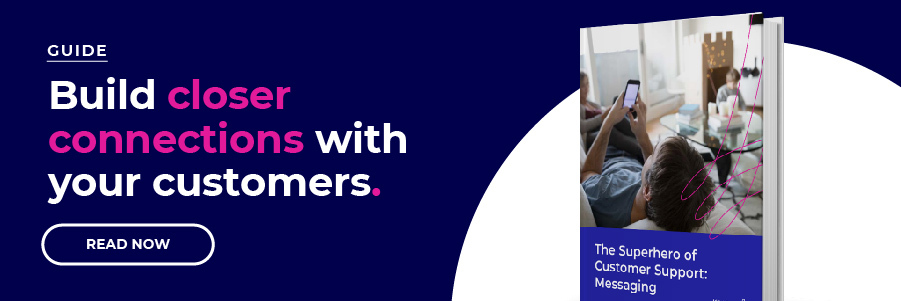 Logo
Logo
EXPERT INSIGHTS
Oct-05-2023
Understanding synchronous vs. asynchronous messaging
Khoros Staff
Systems that handle synchronous messaging (conversations in real-time) and asynchronous messaging (conversations across different time periods) dominate the modern customer service messaging landscape. Each type of messaging requires different technology, workflows, and best practices, and each has its own set of pros and cons.
To help you decide which messaging style is right for your business's customer service sector(s), let's take a closer look at what synchronous and asynchronous messaging systems involve, the benefits and challenges that come with each approach, and whether there is a third option that marries the best of both worlds.

What is synchronous messaging?
Synchronous messaging is a live one-to-one conversation with a defined beginning and end. Common examples of synchronous messaging involve phone calls, video calls, and live web chat.
In the context of customer support, the ideal scenario would be something like: An agent learns about, discusses, and solves the customer’s issue(s), then ends the conversation. Notably, synchronous messaging provides the benefit of human interaction, which in and of itself carries several benefits and drawbacks.
Synchronous messaging is most suitable for simple conversations that can be solved by one agent and in one sitting.
Traditional support just doesn’t cut it anymore. Learn how to leverage emerging messaging platforms to build closer relationships with your customers.
Pros of synchronous messaging
Human interaction: Customers find talking to a real person productive. Speaking with another person creates a personalized moment, which may help address concerns more effectively.
Immediate problem resolution: When possible, customers can get answers to their questions and have their problems addressed promptly, leading to quick issue resolution.
Frustration venting: Customers appreciate having their frustrations heard. While perhaps not fun for your customer service agent, allowing the customer to vent can help foster a sense of empathy and understanding with regard to whatever issue is being discussed.
- Real-time communication: Particularly beneficial in live chat, customers can avoid the slow nature of email communication and receive instant responses.
Cons of synchronous messaging
Limited capacity and time on hold: Agents can assist only one customer at a time, leading to wait times and potential frustration for other customers. Customers may spend valuable time on hold, whether in live chat queues or on phone calls, leading to dissatisfaction and frustration before a conversation can even begin.
Expertise challenges and repetition: Representatives might lack the necessary expertise to solve complex problems, leading to escalations and handoffs and frequently resulting in the need for customers to repeat their complaints.
Session dependency: Synchronous messaging requires both parties to be available simultaneously; if a customer steps away (and who among us hasn’t accidentally done that at one time or another) the session ends, causing disruptions in communication and/or the need for the customer to start all over again.
Frustration from unresolved issues: Not all issues can be resolved with a quick phone call or chat — that’s just life. But in a recent survey, we found that 68% of customers are extremely frustrated when chat sessions end without a resolution.
What is asynchronous messaging?
Asynchronous communication doesn’t require both parties to be present and speaking at the same time. This can be great for customers who would rather have the option to start, pause, and resume a conversation at their convenience.
Asynchronous messaging can provide a better experience than synchronous messaging when the issues being discussed are complex, as it requires more than one sitting to fix or needs input from multiple agents.
The most recognizable form of asynchronous communication is e-mail, but asynchronous chat — which we’ll discuss in a minute — has become increasingly popular in the customer service response space.
Asynchronous messaging is more convenient for customers who are looking for solutions to complex issues.
Meet the new superhero of customer support: Messaging. Download our free whitepaper to learn more.
Pros of asynchronous messaging
Flexibility and convenience: Asynchronous messaging allows customers to communicate on their own time, providing the flexibility to articulate their issues or questions without the pressure to respond immediately. This can be hugely helpful to customers who need to reach out to customer service agents in the middle of a busy workday, who work at odd hours, or who are otherwise being pulled in multiple directions.
Clearer, more comprehensive communication: Without the limitations of real-time conversation, customers can take the time to clearly outline their concerns, reducing misunderstandings and making it more likely that agents will receive detailed explanations of problems. Meanwhile, agents can also take their time to research and provide comprehensive solutions, enhancing the quality of responses and customer satisfaction.
Multitasking: Customers can engage in other activities while waiting for a response, making it convenient for busy individuals to seek assistance without dedicating constant attention. When messages aren’t urgent, customer service agents can also better prioritize responses, creating a more meaningful and beneficial workflow.
Improved “open” rate: In a way, asynchronous messaging is the new email — but without the clunky threads that can get easily lost in an already crowded inbox. Less than a quarter of all emails are opened (any kind, not just those from customer support); how many emails have your agents spent time on, only to never have them be read?
Cons of asynchronous messaging
Delayed responses: Without real-time conversation, customers might experience delays in receiving answers. When urgent assistance is needed this type of prolonged issue resolution may lead to frustration, especially when a customer's needs are urgent.
A loss of human interaction: Asynchronous communication lacks the personal touch of real-time conversations, potentially impacting the emotional connection between the customer and the support team. This drawback, however, can be changed by how personable your customer service agent chooses to be — a lot of warmth can be conveyed even in writing alone.
Dependency on written communication skills: To that end, effective asynchronous communication requires strong written communication skills, which some customers or even agents might lack, leading to misunderstandings and miscommunication.

How asynchronous communication via chat can revolutionize the customer experience
Phone, email, and live chat have all been mentioned here, and we’ve already determined that they each have their limitations. What solution are we looking at, then? Telepathy? Or perhaps your dear uncle Randy, who seemingly has an answer for everything that’s wrong in the world?
Not exactly. We’re going to revisit one of those — chat — but through a different lens.
When most people think of chat, they’re imagining the old, session/device-based synchronous chat. Modern messaging protocols, however, can operate independently of device or session.
To put it another way, asynchronous chat operates using concurrency —a fancy word for multitasking. Concurrency acknowledges the pauses and stops in chat interactions, allowing agents and customers to utilize those gaps for ramped-up efficiency and productivity.
When you’re not required to be on the phone/chat with a single person for a single session, agents can help a second or third customer at the same time, and customers can hop on a conference call or go pick up their kids. From a business perspective, taking advantage of concurrency in this way significantly increases productivity.
For example, using Khoros Modern Chat, agents are able to manage twenty - thirty customer conversations simultaneously. Not only does this allow agents to help more people, reducing wait times for customers, but it can also reduce support calls overall.
Take the following story from one of our customers as an example: A major telecom brand needed a way to head off account data questions posed on social media. Traditionally, authenticating customers’ identities is done most securely over the phone. In this instance, it required shifting from social media to a phone call, which led to an interruption in care.
To solve customer issues quickly and effectively, the brand worked with Khoros to securely authenticate customers through messaging without “changing lanes,” resulting in a 77-percent reduction in expensive customer calls and a significant increase in positive customer sentiment.
Explore the benefits of asynchronous chat with Khoros
Since more and more messaging channels have emerged, companies have embraced the opportunity to foster closer connections with their customers. But the true marker for success is being where your customers are wherever and however they need you.
One key to ensuring that is embracing the fast-moving changes in the way we communicate to customers. To learn more about how asynchronous messaging can help you improve your customer service experience, visit the Khoros Messaging page today.











